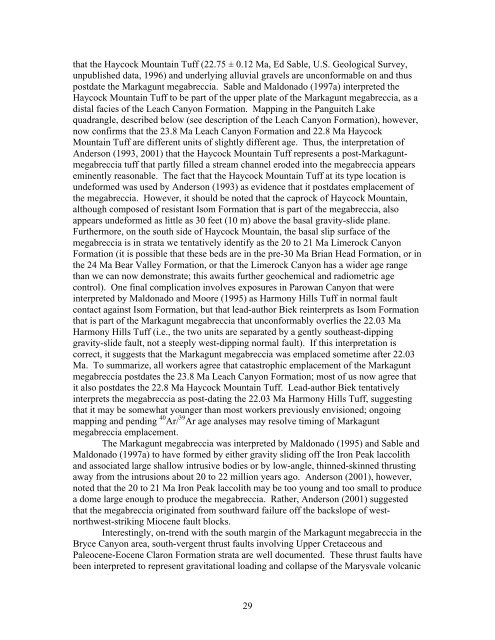Interim Geologic Map of the West Part of - Utah Geological Survey
Interim Geologic Map of the West Part of - Utah Geological Survey
Interim Geologic Map of the West Part of - Utah Geological Survey
You also want an ePaper? Increase the reach of your titles
YUMPU automatically turns print PDFs into web optimized ePapers that Google loves.
that <strong>the</strong> Haycock Mountain Tuff (22.75 ± 0.12 Ma, Ed Sable, U.S. <strong>Geologic</strong>al <strong>Survey</strong>,unpublished data, 1996) and underlying alluvial gravels are unconformable on and thuspostdate <strong>the</strong> Markagunt megabreccia. Sable and Maldonado (1997a) interpreted <strong>the</strong>Haycock Mountain Tuff to be part <strong>of</strong> <strong>the</strong> upper plate <strong>of</strong> <strong>the</strong> Markagunt megabreccia, as adistal facies <strong>of</strong> <strong>the</strong> Leach Canyon Formation. <strong>Map</strong>ping in <strong>the</strong> Panguitch Lakequadrangle, described below (see description <strong>of</strong> <strong>the</strong> Leach Canyon Formation), however,now confirms that <strong>the</strong> 23.8 Ma Leach Canyon Formation and 22.8 Ma HaycockMountain Tuff are different units <strong>of</strong> slightly different age. Thus, <strong>the</strong> interpretation <strong>of</strong>Anderson (1993, 2001) that <strong>the</strong> Haycock Mountain Tuff represents a post-Markaguntmegabrecciatuff that partly filled a stream channel eroded into <strong>the</strong> megabreccia appearseminently reasonable. The fact that <strong>the</strong> Haycock Mountain Tuff at its type location isundeformed was used by Anderson (1993) as evidence that it postdates emplacement <strong>of</strong><strong>the</strong> megabreccia. However, it should be noted that <strong>the</strong> caprock <strong>of</strong> Haycock Mountain,although composed <strong>of</strong> resistant Isom Formation that is part <strong>of</strong> <strong>the</strong> megabreccia, alsoappears undeformed as little as 30 feet (10 m) above <strong>the</strong> basal gravity-slide plane.Fur<strong>the</strong>rmore, on <strong>the</strong> south side <strong>of</strong> Haycock Mountain, <strong>the</strong> basal slip surface <strong>of</strong> <strong>the</strong>megabreccia is in strata we tentatively identify as <strong>the</strong> 20 to 21 Ma Limerock CanyonFormation (it is possible that <strong>the</strong>se beds are in <strong>the</strong> pre-30 Ma Brian Head Formation, or in<strong>the</strong> 24 Ma Bear Valley Formation, or that <strong>the</strong> Limerock Canyon has a wider age rangethan we can now demonstrate; this awaits fur<strong>the</strong>r geochemical and radiometric agecontrol). One final complication involves exposures in Parowan Canyon that wereinterpreted by Maldonado and Moore (1995) as Harmony Hills Tuff in normal faultcontact against Isom Formation, but that lead-author Biek reinterprets as Isom Formationthat is part <strong>of</strong> <strong>the</strong> Markagunt megabreccia that unconformably overlies <strong>the</strong> 22.03 MaHarmony Hills Tuff (i.e., <strong>the</strong> two units are separated by a gently sou<strong>the</strong>ast-dippinggravity-slide fault, not a steeply west-dipping normal fault). If this interpretation iscorrect, it suggests that <strong>the</strong> Markagunt megabreccia was emplaced sometime after 22.03Ma. To summarize, all workers agree that catastrophic emplacement <strong>of</strong> <strong>the</strong> Markaguntmegabreccia postdates <strong>the</strong> 23.8 Ma Leach Canyon Formation; most <strong>of</strong> us now agree thatit also postdates <strong>the</strong> 22.8 Ma Haycock Mountain Tuff. Lead-author Biek tentativelyinterprets <strong>the</strong> megabreccia as post-dating <strong>the</strong> 22.03 Ma Harmony Hills Tuff, suggestingthat it may be somewhat younger than most workers previously envisioned; ongoingmapping and pending 40 Ar/ 39 Ar age analyses may resolve timing <strong>of</strong> Markaguntmegabreccia emplacement.The Markagunt megabreccia was interpreted by Maldonado (1995) and Sable andMaldonado (1997a) to have formed by ei<strong>the</strong>r gravity sliding <strong>of</strong>f <strong>the</strong> Iron Peak laccolithand associated large shallow intrusive bodies or by low-angle, thinned-skinned thrustingaway from <strong>the</strong> intrusions about 20 to 22 million years ago. Anderson (2001), however,noted that <strong>the</strong> 20 to 21 Ma Iron Peak laccolith may be too young and too small to producea dome large enough to produce <strong>the</strong> megabreccia. Ra<strong>the</strong>r, Anderson (2001) suggestedthat <strong>the</strong> megabreccia originated from southward failure <strong>of</strong>f <strong>the</strong> backslope <strong>of</strong> westnorthwest-strikingMiocene fault blocks.Interestingly, on-trend with <strong>the</strong> south margin <strong>of</strong> <strong>the</strong> Markagunt megabreccia in <strong>the</strong>Bryce Canyon area, south-vergent thrust faults involving Upper Cretaceous andPaleocene-Eocene Claron Formation strata are well documented. These thrust faults havebeen interpreted to represent gravitational loading and collapse <strong>of</strong> <strong>the</strong> Marysvale volcanic29
















